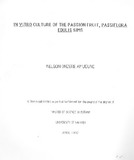| dc.description.abstract | Passion fruit (Passiflora edults Sims) belongs to the family Passifloraceae. The genus
Passlflora Includes more than 350 species of sub-tropical vines, most of which climb by
tendrils. Only a few species are grown for their edible fruit. Among the cultivated species,
P. edulis Sims has great commercial value, especially for juice extraction. Two varieties of
E. edulis are recognised: E. edulis var. edulis, the purple passion fruit and P. edulis ver.
flavicarpa, the yellow passion fruit. Both varieties are grown in Kenya on a commercial scale.
The purple form is better suited to the high lands while the yellow form does best at low
altitudes. Brown spot and woodiness are the most important diseases of this crop, while the
most serious pests include, root nematodes, aphids and bugs, especially in the purple variety.
In this study, a tissue culture method, which can be used for rapid multiplication of the
yellow passion fruit is described. Callus was initiated from different explants of the yellow
and purpIe passion fruit. Immature seeds of var edul is formed callus when inoculated on MS
,
(Murashlge and Skoog) medium containing 1-3 mg/I C4-napthaleneacetic acid (NAA) and 0.5
mg/I 6-benzylamlnopurine (BAP). Stem explants of var. edulis and var. flavicarpa formed
callus when inoculated on MSmedia supplemented with 2,mg/1 NAA, with or without 0.5 mg/I
BAP. Stem segments with nodes formed shoots when inoculated on MS medium with 2 mg/l BAP
or 2 mg/l BAP and 0.2 .mg/l NAA.
Leaf discs of var. f18vicarpa formed callus when inoculated on MS medium supp lemented
with 2 mg/l NAA, 2 mg/l indole-3-acetic acid (IAA) and'O.4 mg/l kinetin (KIN). Those
inoculated on medium with 2 mg/l NAAor 2 mg/l NAAand 0.5 mg/l KIN formed callus and
roots within 4 weeks. Shoots were observed on leaf discs of var. flavicarpa inoculated on MS
medium supplemented with 2 mg/l BAP or 2 mg/l BAP and 0.5 mg/l KIN within 4 weeks. The
, .
shoots were then subcultured onto MS medium supp lemented with 0.1 mg/l BAP for further
,
growth. Such shoots could be induced to root when subcultured onto MS media containing 0.1 ,
0.5 and 1 mg/l NAA.Rootedplantlets could be obtained within 8 weeks.
ix
In this study, investigations were also carried out to determine whether passion fruit is
a host for infection by Agrobacterium.
Agrobacterium tumefaciens is a Gram-negative soil bacterium that can cause the
formation of tumours on certain woundedplants. This bacterium harbours an oncogenic Ti
plasmid which enables it to induce crown gall tumours on most dicotyledonous and some
monocotyledonous plants. The Ti plasmid has a segment, called the T-DNA, which is
transferred from the bacterium and becomesstably integrated into the plant genome.Hence,
8.. tumefaciens can be usedas a vector to transfer foreign genes into plants.
Results obtained showed that passion fruit is susceptible to Agrobacterium infection.
Tumours were induced on the plant infected with the hypervirulent 8.. tumefaciens strain
A281. Thesetumours could grow on MS medium without hormones, free of the inciting
bacteria. Agropine, a compound whose synthesis is directed by 8.. tumefaciens genes, could be
detected in the tumour tissue. These findings open the possibility of improving passion fruit
by genetic engineering.
Experiments doneto investigate the problem of seeddormancy in passion fruit revealed
that the tough seedcoat could be the major cause. It was established that dormancy could be
broken by scarification and treatment of the scarified seeds with gibberellic acid.
Future work should include a tissue culture method that can be used for rapid
multiplication of ver. edulis as has been described for var. flavicarpa. Attempts should be
madeto return plantlets of ver. flavicarpa back to in vivo conditions and compare them with
plants germinated from seeds.Genetic traits that could bi.studied include wilt resistance,
which is controlled by a single locus. Further work could also be doneto see whether passion
fruit can be improved by genetic engineering using the Agrobacterium system, especially its
resistance to woodiness diseasewhich is caused by cucumber virus I. | en |

